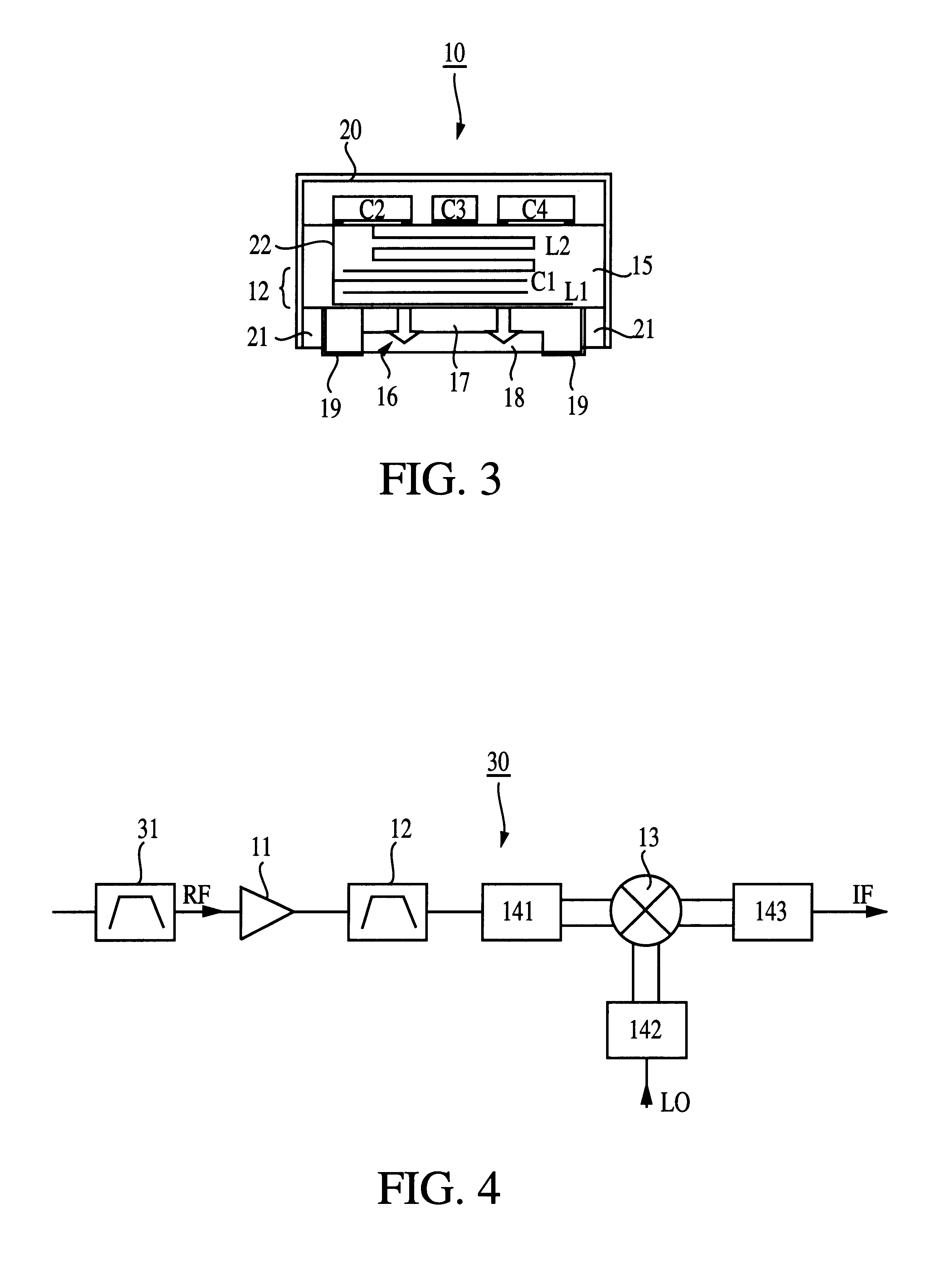Receiving module and receiver
a receiver and module technology, applied in the direction of demodulation, electrical equipment, transmission noise suppression, etc., can solve the problems of insufficient isolation between the local oscillation signal terminal and the received signal terminal, the inability to simultaneously attenuate the local oscillation signal and the half-image signal with a single high frequency filter having a wide pass band, and the inability to have such steep characteristics
- Summary
- Abstract
- Description
- Claims
- Application Information
AI Technical Summary
Benefits of technology
Problems solved by technology
Method used
Image
Examples
first embodiment
FIG. 1 is a block diagram of a receiving module according to the present invention. A receiving module 10 is constituted of a low-noise amplifier 11, a high frequency LC filter 12, a Gilbert-cell type mixer 13, and baluns 141 to 143.
A signal RF received by an antenna (not shown) is amplified by the low-noise amplifier 11. After passing through the LC filter 12 and the balun 141, the signal RF is input to the Gilbert-cell type mixer 13 to be mixed with a local oscillation signal LO input to the Gilbert-cell type mixer 13 via the balun 142. Then, an intermediate frequency signal IF obtained as the result of conversion by the Gilbert-cell type mixer 13 is output via the balun 143.
FIG. 2 is a circuit diagram of the Gilbert-cell type mixer 13 constituting the receiving module shown in FIG. 1. The Gilbert-cell type mixer 13 is constituted of six transistors Q1 to Q6 and four resistors R1 to R4.
The bases of the transistors Q1 and Q4, and the bases of the transistors Q2 and Q3 are connected...
second embodiment
In the receiving module 30 of the second embodiment, since the Gilbert-cell type mixer is used, sufficient isolation between the terminals of the mixer can be obtained. As a result, leakage of received signals from a received signal terminal to a local oscillation signal terminal can be suppressed. Thus, since it is not necessary to dispose a high frequency filter for eliminating received signals between the local oscillation signal terminal and the local oscillation circuit, the receiving module can be made compact.
Since sufficient isolation can be obtained between the terminals of the mixer, and the Gilbert-cell type mixer capable of canceling even-order harmonics is used, leakage of received signals from a received signal terminal to a local oscillation signal terminal can be suppressed, and occurrence of half-image signals can also be suppressed. Therefore, the high frequency filter disposed between the low-noise amplifier and the mixer does not have to attenuate local oscillati...
PUM
 Login to View More
Login to View More Abstract
Description
Claims
Application Information
 Login to View More
Login to View More - R&D
- Intellectual Property
- Life Sciences
- Materials
- Tech Scout
- Unparalleled Data Quality
- Higher Quality Content
- 60% Fewer Hallucinations
Browse by: Latest US Patents, China's latest patents, Technical Efficacy Thesaurus, Application Domain, Technology Topic, Popular Technical Reports.
© 2025 PatSnap. All rights reserved.Legal|Privacy policy|Modern Slavery Act Transparency Statement|Sitemap|About US| Contact US: help@patsnap.com



